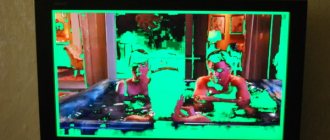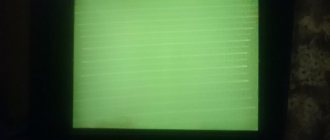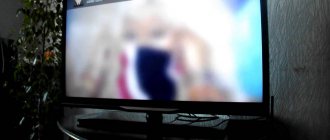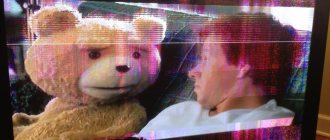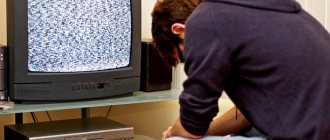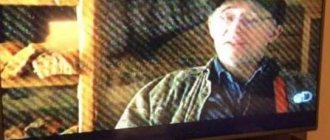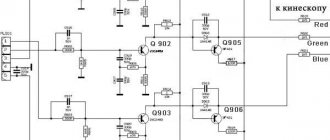Does the TV change color, shows an inverse image, does one of the tones disappear or predominate? This problem is faced by owners of old CRT receivers made by JVC or Supra and those who bought a modern flat-panel Samsung or Panasonic. The cause of the problem depends on factors such as signal quality, type of TV (CRT, LED, plasma panel), age of the device, natural wear and tear of electronic components, etc. In simple cases, the problem can be solved independently. If we are talking about damage to internal components, you should call a repairman.
Service engineers will quickly come to your home, conduct diagnostics, identify the source of the defect and fix it in a matter of hours. To order an inexpensive TV repair in Moscow, call us at our number or place an online order for a technician to visit you through the website.
Why did the screen turn green?
If the TV shows green, it is difficult to determine the fault yourself:
- Transistor failure. The green video amplifier breaks through, as a result of which the screen is painted in one tone, only the shades change.
- The cathode is closed with the modulator.
- There is a capacitor leak.
- Emission lost.
Yellow-green shades appear as a result of incorrect settings or a damaged microcircuit .
Reasons for the absence of an image on the screen
The image on the TV disappeared - after turning it on, a common complaint from users
. The manufacturer's splash screen appears on the monitor, and then the image disappears. This is a good sign indicating that the screen is in working order. In such cases, the cause of no picture is faulty cables or tuner, loose connections, or incorrect settings.
A completely black screen usually indicates that a serious breakdown has occurred and the device needs to be repaired and parts replaced. Most often they fail:
- Display backlight system. Diodes burn out or the inverter that converts electricity and supplies it to the lamps breaks down;
- The liquid crystal matrix is the most unpleasant malfunction. Problems with the node can appear gradually - first in the form of picture distortion and a large number of empty pixels on the monitor, over time the image on the TV disappears completely. In many cases, it is more expedient to buy a new device than to repair an old one.
- Power board. The weak point of the unit is the filter capacitors, which burn out due to unstable voltage.
TV shows red picture
If your TV shows red, check your settings. Common human factors often cause problems. You probably accidentally increased the red saturation.
Sometimes the source of trouble is the antenna. The signal arrives from the satellite in normal mode, then is transmitted from the antenna to the TV incorrectly. It can distort colors, the picture disappears, and so on. Failure is characterized not only by a loss of quality, but also by associated failures (streaks, ripples or spots).
due to dust . Dust damages the surfaces of parts. Sooner or later this will lead to errors or complete failure of the equipment.
Causes of malfunctions and their manifestations
The main reasons that caused clearly visible distortions to appear on the screen are:
- Malfunctions in the operation of the inverter (backlight converter).
- One of the screen matrix bulbs is burnt out or damaged.
- Incorrect operation of the entire reproducing system due to other reasons.
And finally, the appearance of distortion can be caused by malfunctions of the color unit or elements of the motherboard (swelling of capacitors, for example).
Important! Most of these malfunctions mainly relate to the matrix elements of the TV.
This once again confirms the importance of careful handling of this working unit. Only a strong impact or deformation of the screen can lead to disturbances in the matrix backlight. Another common explanation for its failure is a strong voltage surge, often observed during the operation of industrial and household networks. The likelihood of this event is especially high in rural areas, where voltage drops or deviations from the norm are considered normal. Damage to the matrix can also be caused by an accidental lightning strike on the consumer's electrical network, when a lightning discharge penetrates all household appliances connected to it.
The characteristic manifestations of each of the listed malfunctions are:
- General darkening of the screen.
- The appearance of alternating colored stripes on it (photo below).
- Small ripples in the picture, traditionally called "snow".
- Image blinking .
- The disappearance of one of the primary colors.
- The appearance of dark spots and spots.
Additional information: Sometimes characteristic disturbances in the operation of an LCD TV appear as a wild bloom of all colors.
In any of the cases considered, repairing the television receiver should begin only after the cause of the malfunction has been identified.
What to do if the TV shows everything in blue tones
When the TV shows blue, as in the previous version, the problem may lie in the settings. Other reasons:
- The thermistor is broken. It controls the temperature. Inside the apartment, the temperature can change, but the thermistor keeps it in the hardware at the same level. If it breaks, overheating occurs.
- Magnetization of the kinescope. There are other parts nearby that create a weak magnetic field. It gradually affects the kinescope until it stops working.
- Poor contact. If the plug comes out, you will need to call a repairman to your home. Therefore, it is recommended to examine all connections and connections.
How to Fix Samsung TV Color Distortion
Even with 4K Ultra HD resolution, HDR, and wide color gamut, chances are you'll expect the best but end up with the worst. Modern TVs suffer from the common problem of screen flickering and dimming.
Features such as image stabilization and power saving features do not work properly and instead cause problems such as color distortion on the Samsung TV. There is a possibility that the problem may be caused by a wire or other external equipment.
Picture quality matters a lot if you want to watch your favorite TV shows, movies and series on your Samsung TV. Samsung TV has advanced color settings feature. To adjust advanced color settings on your Samsung TV, follow the steps below.
Method 1: Advanced Color Settings on Samsung TV
Step 1: Samsung TV .
Step 2: Press the " Menu " button on your Samsung TV remote control.
Step 3: Now find and tap the option labeled “ Picture ” to open the video options on your Samsung TV.
Step 4: From the image menu, scroll down and find and select the "HUE" option. The HUE feature adjusts the green and red levels on any TV. You can balance the red and green lights, or increase or decrease one to suit your taste.
Step 5: Once you're done with balancing the green and red light, go to the "Color Saturation" option.
Step 6: If you notice that the colors are bleeding into the background, then in the Color Saturation you can always reduce the contrast.
Step 7: In the Color Saturation , select the Color Temperature .
Step 8: Color Temperature sets the overall color level of the TV. If you notice that the red color is too intense, you should change the color to "Cool" and set it to "Warm" if the color is blue.
There is a chance that depending on which model of Samsung TV you are using, the settings may be different.
Method 2: Disable Eco Sensor feature
To disable the Eco Sensor function, follow the steps below.
Step 1: Samsung TV .
Step 2: Press the menu on your Samsung TV remote control.
Step 3: Open Settings .
Step 4: Find and click " Eco Sensor ".
Step 5: From there, turn off or disable the Eco .
Turning off or disabling the Eco Sensor function will disable automatic adjustment of ambient light brightness.
Method 3: Turn off the power saving feature
To disable the power saving feature, follow the steps below.
Step 1: Samsung TV .
Step 2: Press the menu on your Samsung TV remote control.
Step 3: Open Settings .
Step 4: Find and tap " Energy Saver ".
Step 5: From there, turn off or disable the " power saving " feature.
By disabling or disabling the "power saving" feature, your Samsung TV will not automatically adjust brightness based on the show you're watching.
Method 4: Expert Settings
Step 1: Samsung TV .
Step 2: Press the " Menu " button on your Samsung TV remote control.
Step 3: Now open quick settings on your Samsung TV.
Step 4: In quick settings, go to picture mode . Picture mode has four display presets: Dynamic, Standard, Natural, and Film . You can choose any preset or mode that suits you best and the one that solves your Samsung TV color distortion problem.
Step 5: In Picture Settings, if you are looking for more detailed settings, you can also open Advanced Settings in Picture Mode .
Step 6: Expert settings help you adjust several parameters such as Backlight , Brightness , Contrast , Sharpness , Color and Tint on Samsung displays or TV screens. You can adjust these settings to get rid of color distortion on your Samsung TV.
Step 7: Expert settings also have some other features such as Digital Clean View, Auto Motion Plus, local dimming, HDR controls, and color balancing presets.
Conclusion
The methods listed above are tried and tested methods that have worked great. In case the problem is not resolved even after changing the settings, the problem may also be caused by a faulty wire, poor connection or a faulty receiver. In such cases, you should contact our 24/7 technical support team for assistance.
The colors have been swapped, one of the colors is missing
If the colors on the TV have changed, you need to look at the characteristics of the programs and check if there is a firmware update. Software for modern technology plays an important role. Some models download updates themselves, for others this is done by the user using his computer.
When the color of the TV screen not only changed, but one hue disappeared, the corresponding color block is probably out of order . In this case, contact the service center. It is important that he has his own warehouse of original spare parts. It is not recommended to install non-original parts, as they quickly break and can harm adjacent boards and circuits.
Diagnostics and testing
If, when diagnosing a malfunction, the cause of distortion is damage in the matrix itself or in its individual elements, then the only way out is to completely replace the module. But first, it is recommended to once again verify the correctness of the assessment made by installing a known-good matrix in the TV. The burnout of one of the light bulbs of this element is diagnosed by significant dimming of individual areas of the screen.
If strong ripples or so-called “snow” are detected on it, attention is first of all drawn to the receiving part of the TV (its antenna, cable, or the correct settings of the channels being watched). If one of the color components (blue, red or green) disappears, we can conclude that there are problems in the operation of the unit responsible for their formation or the video amplifier. Testing for this malfunction is carried out according to the same scheme as in the case of checking the matrix (replacing the block that has raised doubts with another, known-to-be-good module).
DIY repair
Do-it-yourself TV repair is allowed in case of trivial breakdowns, such as lost settings, loose plugs, etc. More complex cases are dealt with professionally. You can open and get to the hardware of the equipment if you have the appropriate skills.
If there are none, contact our company: we will repair any type of TV: CRT, plasma or LCD. We are open daily from 8:00 to 22:00, and you can contact us by number 8 , or through the feedback form on the website. You can order a technician to come to your home at any time convenient for you. Upon completion of the repair, a quality guarantee is provided for the work done.
Recommendations from engineers
Operators of the A-Iceberg SC often receive calls with complaints about inverted video. At the same time, the problem manifests itself on equipment of many well-known brands, regardless of cost and functionality.
To reduce the likelihood of an inverted image appearing, use the recommendations from our engineers.
- Do not install the TV in rooms with high levels of humidity or dust. There is a high probability that such an environment will damage the board.
- Transport LCD panels with extreme care and do not allow them to be dropped or bumped.
- To avoid problems with network voltage, connect equipment through a household stabilizer.
- If signal distortion and inversion are detected, disconnect the equipment from the network and call a technical center employee.
Remember that eliminating such a flaw is a rather complex process, requiring practical skills and extreme care from the performer (especially when it comes to re-soldering microcircuits). Unskilled actions usually lead to additional breakdowns or render the device completely unsuitable for further use. It is better to call a specialist who will eliminate the defect quickly and efficiently.
Types of stripes on a TV screen
A defect in the television screen in the form of stripes that appear has a negative impact not only on image quality, but also on the operation of hardware modules, due to the failure of which such problems arise. As a result, their service life is significantly reduced.
The most common types of stripes on a TV screen:
- thin horizontal;
- thin vertical;
- multi-colored horizontal;
- pink vertical;
- white vertical;
- blue vertical;
- green vertical;
- red vertical;
- black vertical and horizontal;
- yellow vertical;
- white horizontal.
This list does not represent all the variety of such defects on the screen. Stripes on a TV screen can be single or multiple, short or long, but are mainly divided into vertical, horizontal and multi-colored.
The problem may periodically appear and disappear, but under no circumstances should such a defect be left unattended - in the end it threatens an even more serious breakdown.
